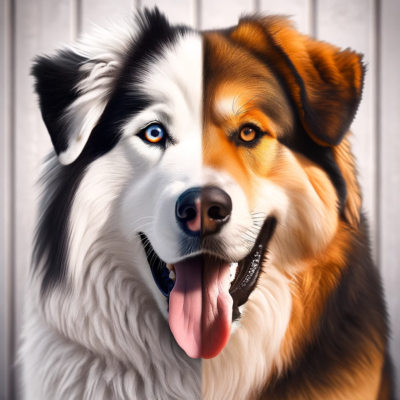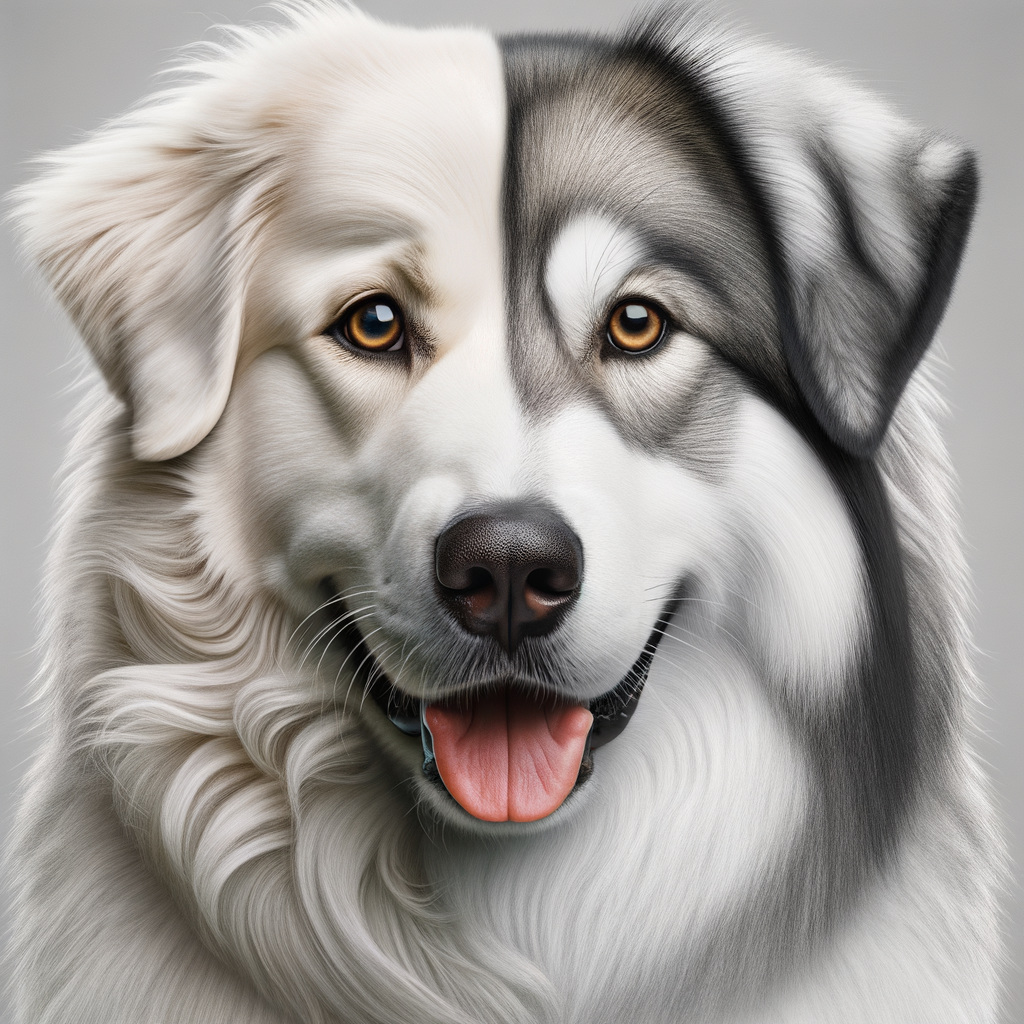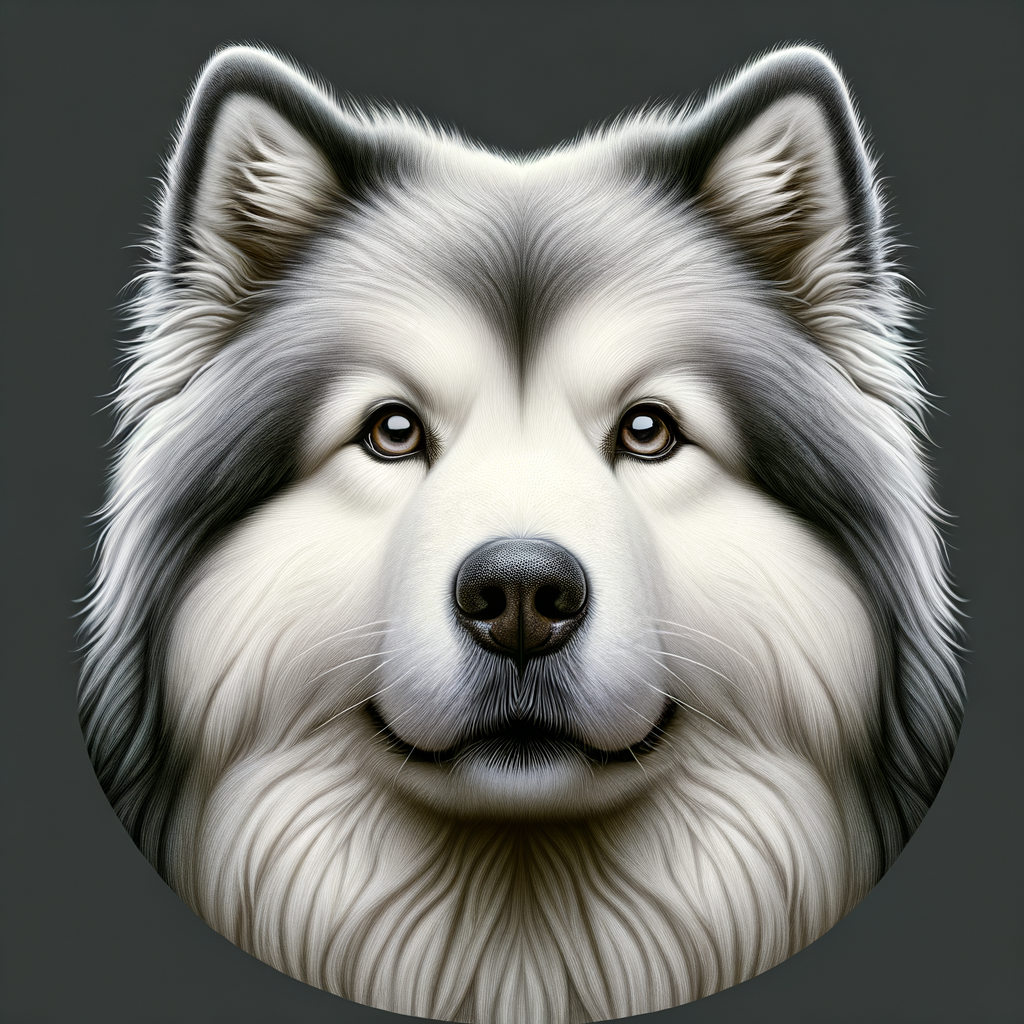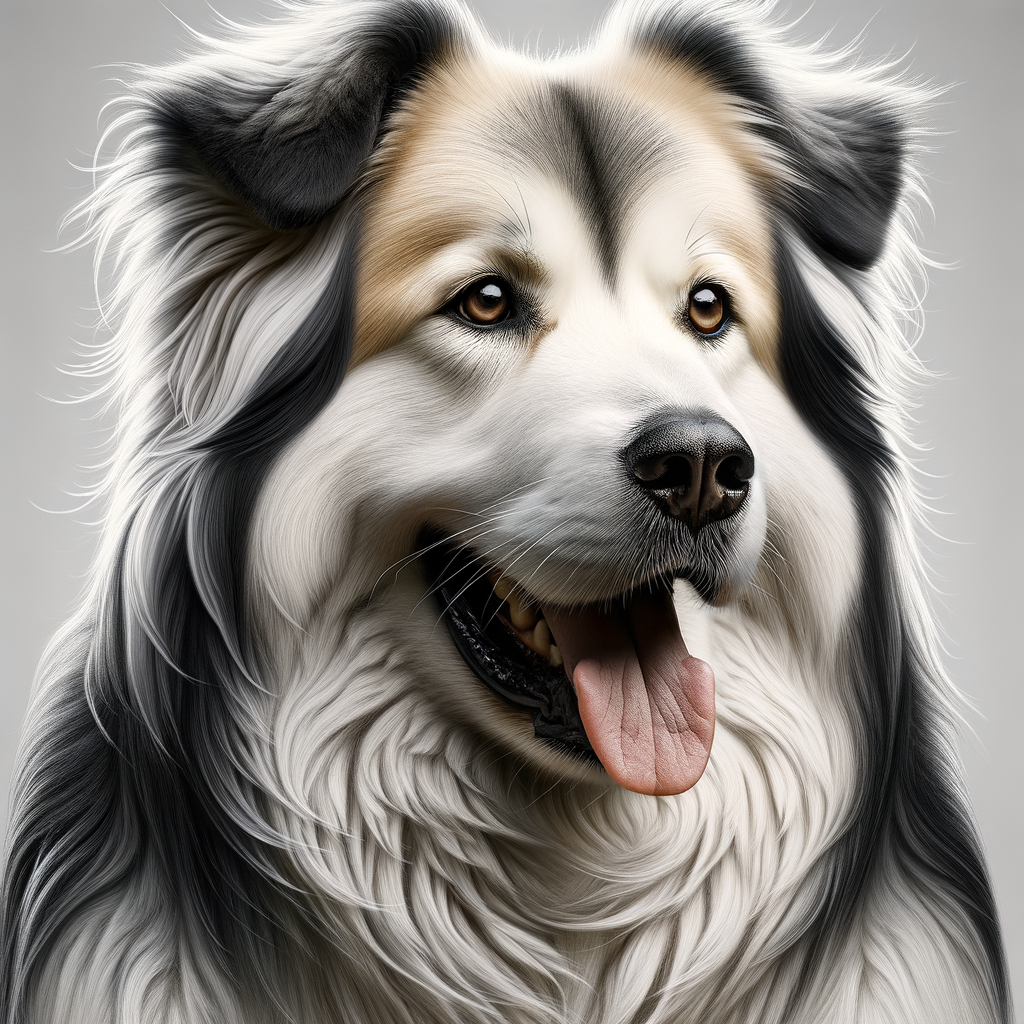As a holistic veterinarian, I’ve had the pleasure of encountering many unique and fascinating dog breeds. Among them, the Great Pyrenees Husky mix, also known as the Pyrsky, has always stood out due to its majestic appearance and remarkable temperament. In this article, we’ll delve into the characteristics, care requirements, and other essential details you need to know about this beautiful hybrid breed. Whether you’re considering adopting a Pyrsky or simply curious about this mix, read on to become acquainted with this truly majestic dog breed.

General Temperament Of the Great Pyrenees Husky Mix
Imagine finding a loyal companion who is not just a pet but also a great friend and family member. That’s the magic of bringing a Great Pyrenees Husky mix into your life. This stunning breed has a unique temperament, blending the best traits of the Great Pyrenees and Siberian Husky. Let’s dive into the character traits of this beautiful breed to help you understand if it’s the perfect fit for your family.
Is Great Pyrenees Husky Mix Family & Kid Friendly
Known for their friendliness and affectionate nature, the Great Pyrenees Husky mix, often referred to as a Pyrsky, is a fantastic family pet. They are known to form deep bonds with their human families, including children. Pyrskies have a gentle disposition and are patient with kids, making them an excellent choice for families with little ones.
However, both Great Pyrenees and Siberian Huskies are known for their protective instincts, so your Pyrsky may display protective behavior around your family, particularly with children. While this is a trait many families appreciate, it’s essential to ensure that this protective nature is well-managed and doesn’t become overbearing.
Energy Level Of Great Pyrenees Husky Mix
When it comes to energy levels, Pyrskies are quite active. Remember, this breed is a mix of two working dogs – the Great Pyrenees, a livestock guardian, and the Siberian Husky, a sled dog. Therefore, a Great Pyrenees Husky mix needs plenty of physical activity to keep them happy and healthy.
- They love long walks and playtime in the backyard.
- They also enjoy mental stimulation, so interactive toys and puzzles can be a great addition to their routine.
- If you’re an outdoor enthusiast, your Pyrsky will gladly accompany you on hikes and other adventures.
However, despite their high energy, Pyrskies also know when to relax and enjoy quiet time with their family. They are not hyperactive and can adjust well to a relaxed family lifestyle as long as they get their daily dose of exercise.
Understanding the general temperament of the Great Pyrenees Husky mix is vital to ensure they align with your lifestyle and environment. Their friendly and protective nature, coupled with their high energy levels, makes them a fantastic pet for active families. As with any breed, proper training and socialization from a young age will allow your Pyrsky to grow into a well-behaved and loving family member.

Average Lifespan of the Great Pyrenees Husky Mix
The Great Pyrenees Husky mix, also known as the Pyrsky, is a large breed dog that typically lives between 10 to 15 years. This lifespan is an average for large breed dogs, but remember, these are just averages, and individual lifespans can vary depending on a range of factors, including diet and lifestyle.
How Diet Affects Lifespan
Nutrition plays a significant role in the overall health and lifespan of your Great Pyrenees Husky mix. A balanced diet rich in high-quality proteins, carbohydrates, and fats is essential to keep your Pyrsky healthy and thriving.
The right diet can help maintain a healthy weight, keeping obesity and related health issues at bay. It can also contribute to a shiny coat, good digestion, and a robust immune system. On the other hand, a poor diet can lead to a myriad of health problems like diabetes, heart disease, and joint issues, which could potentially shorten your dog’s lifespan.
The Holistic Vet’s Perspective on How Spay & Neuter Timing Affects Lifespan
When it comes to spaying and neutering, timing is crucial. New studies have shown that early spay and neuter of dogs can cause joint and bone deformities, disruptions of hormones and development, and increased risk of cancer. This means that there is a greater potential for serious chronic diseases such as thyroid problems and Cushing’s disease.
While spaying and neutering can prevent unwanted pregnancies and certain health issues, it’s important to discuss the right timing with your vet. Each dog is unique, and what works for one might not work for another.
In conclusion, the lifespan of your Great Pyrenees Husky mix can be influenced by several factors, including diet and the timing of spaying or neutering. As a responsible pet parent, it’s up to you to provide your Pyrsky with a balanced diet and to make informed decisions about their health care. Remember, your vet is always there to guide you in making the best choices for your furry friend.
Should You Rescue Or Purchase A Great Pyrenees Husky Mix?
When you’re considering adding a Great Pyrenees Husky mix to your family, one of the first decisions you’ll need to make is whether to rescue or purchase. Both options have their own unique advantages.
Benefits of Rescuing or Adopting
Rescuing or adopting a Great Pyrenees Husky mix is a wonderful choice for several reasons:
- Save a Life: By rescuing a dog, you’re giving them a second chance at a happy life.
- Cost-Effective: Adoption fees are often much less than the cost of buying a puppy from a breeder.
- Support Shelters: Your adoption fee helps shelters continue their important work of rescuing and rehoming animals.
- Adult Dogs: Many rescue dogs are adults, which means they may already be trained and socialized.
It’s important to note that rescue dogs may come with certain challenges, such as behavioral issues or health problems. However, the rewards of giving a dog a loving home far outweigh these potential difficulties.
Benefits of Buying
On the other hand, buying a Great Pyrenees Husky mix from a reputable breeder also has its advantages:
- Health Testing: Reputable breeders often perform genetic testing to ensure their puppies are free from inherited health conditions.
- Early Socialization: Breeders typically start socializing puppies at a young age, which can lead to better behavior as they grow.
- Breed Knowledge: Breeders are usually very knowledgeable about the breed and can provide valuable advice and guidance.
- Puppyhood: Buying a puppy gives you the opportunity to experience their adorable puppy stage and influence their training and socialization from a young age.
Remember, purchasing a puppy should never be an impulse decision. It’s essential to do your research and ensure you’re buying from a responsible breeder who prioritizes the health and wellbeing of their dogs.
Whether you choose to rescue or buy, adding a Great Pyrenees Husky mix to your family is a rewarding experience. These majestic dogs bring a lot of joy and companionship to their families.

Average Cost For A Great Pyrenees Husky Mix
When considering welcoming a Great Pyrenees Husky mix, also known as a Pyrsky, into your home, one of the first questions you might ask is, “How much does a Pyrsky cost?” On average, the price for a Great Pyrenees Husky mix puppy can range from $500 to $1000. However, the cost can fluctuate based on various factors such as the breeder’s reputation, location, the lineage of the parent dogs, and the demand for this breed.
- Breeder’s Reputation: A well-known and respected breeder who has a history of producing healthy, well-socialized puppies may charge more.
- Location: Prices can vary significantly depending on the area. Puppies in urban areas or from high-cost living states can be more expensive.
- Parent Dogs’ Lineage: If the parent dogs come from a line of show or working dogs, the puppies’ price might be higher.
- Demand: If the breed is in high demand, the price can go up.
What To Look For In A Breeder
When searching for a Great Pyrenees Husky mix puppy, it’s crucial to find a reputable breeder. Here are some things to consider:
- Health Testing: A responsible breeder will have health tests done on both parent dogs to ensure they are free from genetic diseases that could be passed on to the puppies.
- Knowledgeable: Good breeders are experts in their breed. They should be able to answer all your questions about the breed’s characteristics, care requirements, and potential health issues.
- Home Environment: The puppies should be raised in a clean, comfortable, and loving environment. This helps to ensure the puppies are well-socialized and comfortable around humans.
- References: A reputable breeder should provide references from previous clients.
- Meet the Parents: Meeting the puppy’s parents can give you a good idea of the puppy’s future temperament and size.
- Contract: A good breeder will provide a contract that outlines the terms and conditions of the sale, including a health guarantee.
Remember, while the initial cost of a Great Pyrenees Husky mix puppy might seem steep, it’s a small price to pay for a loving, loyal, and majestic companion like a Pyrsky. But, don’t forget to factor in the ongoing costs of owning a dog, such as food, grooming, regular vet check-ups, and potential health issues.
Training & Behavior Of Great Pyrenees Husky Mix
Training a Great Pyrenees Husky mix (often referred to as a Pyrsky) can be a rewarding experience, given their unique blend of intelligence and independence. This hybrid breed combines the independence of the Great Pyrenees with the intelligence and energy of the Siberian Husky, creating a dog that is both smart and somewhat stubborn.
Overall Trainability
The trainability of a Pyrsky can be quite variable and largely depends on which parent breed they take after more. If they lean more towards the Husky side, they’ll be intelligent and eager to please but might have a bit of a stubborn and independent streak. This can make training a bit of a challenge. On the other hand, if they lean more towards the Great Pyrenees, they may be a bit more docile and obedient but still retain some independence.
Training a Pyrsky requires a patient and consistent approach. These dogs respond best to positive reinforcement techniques such as treat rewards, praises, and petting. Early socialization and obedience training are crucial for this breed to prevent any potential behavioral issues.
Crate Training Is Recommended And Why
Crate training is highly recommended for a Pyrsky. This is because both the Great Pyrenees and Siberian Husky have a strong instinct to roam. A crate provides a safe and secure environment for your dog when you can’t supervise them directly. It can also be a useful tool in housebreaking your Pyrsky.
Please remember, a crate should never be used as a punishment but instead be a positive and safe space for your dog. Make it comfortable with blankets and toys, and always ensure it’s the right size for your pet.
Potential Negative Behaviors To Watch For With Great Pyrenees Husky Mix
As with any breed, the Great Pyrenees Husky mix can develop some negative behaviors if not properly trained and socialized. Here are a few potential issues:
- Stubbornness: Both parent breeds are known for their independent nature, which can sometimes be interpreted as stubbornness. This can make training a bit of a challenge.
- Roaming: As mentioned earlier, both the Great Pyrenees and Siberian Husky have a strong instinct to roam. This can be managed with proper training and a secure yard.
- Digging: Huskies, in particular, are known for their love of digging. Providing an appropriate outlet for this behavior, like a sandbox, can help manage this.
Remember, every dog is unique and not every Pyrsky will exhibit these behaviors. Proper training, socialization, and understanding of your dog’s individual needs are key to ensuring a well-behaved and happy pet.

Grooming Requirements For Great Pyrenees Husky Mix
The Great Pyrenees Husky Mix, often referred to as the Pyrsky, is a beautiful breed that combines the majestic nature of the Great Pyrenees with the striking looks of a Siberian Husky. This hybrid breed has a thick double coat that requires regular grooming to keep it healthy and looking its best.
What About Shedding
The Great Pyrenees Husky mix is a heavy shedder, inheriting this trait from both parent breeds. Their thick double coat is designed to handle harsh weather conditions, but it also means that they shed a lot, especially during the changing of seasons.
As a dog parent, you should expect to brush your Pyrsky at least once or twice a week to keep their coat healthy and to minimize shedding. This also helps to distribute natural oils throughout the coat, which contributes to a shiny, healthy-looking fur.
It’s advisable to use a de-shedding tool or a slicker brush to effectively remove loose hair. Regular grooming sessions can also be a great bonding experience for you and your Pyrsky.
Excessive Shedding May Be Due To Nutrition
Although shedding is entirely natural for a Great Pyrenees Husky mix, excessive shedding could be a sign of a nutritional deficiency. Your Pyrsky’s diet plays a significant role in the health of their coat.
A balanced diet rich in high-quality proteins, omega fatty acids, and vitamins can contribute to a healthy coat and reduce excessive shedding. Foods rich in Omega-3 and Omega-6 fatty acids, for instance, can help nourish your dog’s skin and fur, reducing dryness and subsequent shedding.
Please note that if your Pyrsky is shedding excessively, it is always a good idea to consult with a vet to rule out any underlying health issues.
In the next part of our guide, we will delve deeper into the nutrition and health of a Great Pyrenees Husky mix. We will provide tips on the best foods for your Pyrsky and how to ensure they are receiving a balanced diet that supports their overall health and well-being.
In the meantime, remember that grooming is more than just about keeping your Pyrsky looking good. It’s also about maintaining their overall health and catching any potential health issues early. Regular brushing can help you spot any unusual skin conditions, lumps, or parasites that may be hiding in their thick fur. As always, if you notice anything unusual, it’s best to consult with a veterinarian.
Proper grooming and nutrition go hand in hand in maintaining your Great Pyrenees Husky mix’s overall health and well-being.
Health Of Great Pyrenees Husky Mix
When it comes to the overall health of a Great Pyrenees Husky mix, these dogs are generally robust and healthy, owing to their mixed breed status. This phenomenon, known as “hybrid vigor,” suggests that mixed breed dogs often enjoy better health than their purebred counterparts. However, they can still be prone to certain health conditions, and it’s important to be aware of these to ensure your Pyrsky hybrid is as healthy and happy as possible.
Overall Health
Like their parent breeds, the Great Pyrenees Husky mix is a sturdy and resilient dog. These dogs are known for their endurance and agility, thanks to the Siberian Husky lineage, and their strength and resilience from the Great Pyrenees side. Regular exercise, a balanced diet, and routine vet check-ups are key to maintaining their overall health.
However, despite their robust nature, there are a few health conditions that this breed can potentially inherit from their parent breeds.
Potential Health Conditions
- Hip Dysplasia: This is a common condition in larger breeds, including both the Great Pyrenees and the Siberian Husky. It’s a genetic condition that causes abnormal formation of the hip joint, leading to pain, lameness, and arthritis in severe cases.
- Eye Conditions: The Husky breed is known for a higher incidence of certain eye problems, such as progressive retinal atrophy and cataracts. Regular eye checks can help detect these issues early.
- Bloat: This is a serious, life-threatening condition that often affects large, deep-chested breeds like the Great Pyrenees. It’s essential to know the symptoms – sudden bloating, restlessness, and attempts to vomit – and seek immediate veterinary care if you suspect your dog is suffering from bloat.
Conclusion
The Great Pyrenees Husky mix, a majestic and loyal breed, is generally a healthy and robust breed. However, being aware of potential health conditions and keeping regular vet visits are vital for their well-being.
Remember, providing a healthy and balanced diet, regular exercise, and lots of love are the best ways to ensure a long, happy life for your Pyrsky hybrid. As a dog parent, knowing what conditions may affect your furry friend helps you be proactive in their care, ensuring they stay healthy and active for many years to come.
A Great Pyrenees Husky mix is more than just a pet; they are a family member. So, let’s give them the best care possible, because they deserve nothing less. After all, their health is our happiness.
Nutrition & Diet For Great Pyrenees Husky Mix
Nutrition Tips From Dr. Candy
Feeding your Great Pyrenees Husky mix, otherwise known as a Pyrsky, a balanced and nutritious diet is crucial for their overall health. As a veterinarian, I often stress the importance of providing a diet that meets their specific needs. Remember, this breed mix is large and energetic, meaning they require a diet rich in proteins and carbohydrates for energy and muscle development.
For the Pyrsky, a high-quality dry kibble is often the best option. This diet provides a balanced blend of nutrients, and it’s beneficial for their dental health. Make sure to select a kibble specifically formulated for large breeds. Avoid feed with large amounts of filler ingredients like corn and wheat, as they provide less nutritional value and can lead to weight gain.
Consider adding some canned food or fresh meat to their diet for added protein. However, be careful not to overfeed them, as both the Great Pyrenees and Husky breeds can be prone to obesity.
Also, keep in mind that Pyrskys, like all dogs, need access to fresh water at all times. Hydration is crucial for their digestion and overall health.
Best Foods For Great Pyrenees Husky Mix
When selecting the best food for your Pyrsky, consider brands that prioritize high-quality, natural ingredients. Here’s a list of some recommended options:
- Blue Buffalo Wilderness High Protein Grain Free, Natural Adult Large Breed Dry Dog Food: This food is high in protein and specifically formulated for large breeds.
- Nutro Ultra Large Breed Adult Dry Dog Food: This brand provides a balanced diet with a blend of proteins, grains, and fruits and vegetables.
- Wellness Large Breed Complete Health Adult Deboned Chicken & Brown Rice Recipe Dry Dog Food: Made with all-natural ingredients, this food offers a balanced diet for large breeds.
Always remember that every dog is unique, and what works best for one Pyrsky might not be the best for another. Monitor your dog’s weight, energy levels and overall health, and adjust their diet as necessary. Consulting with your vet about your dog’s dietary needs is always a good idea.
Maintaining a healthy diet is a crucial part of caring for your Great Pyrenees Husky mix. With the right nutrition, your Pyrsky will have the energy to enjoy their active lifestyle and remain a healthy member of your family for years to come. Remember, a well-fed Pyrsky is a happy Pyrsky!
Frequently Asked Questions
What is a Great Pyrenees Husky Mix?
A Great Pyrenees Husky Mix, also known as a Pyrsky, is a hybrid breed that combines the traits of the Great Pyrenees and the Siberian Husky. This breed is known for its majestic appearance and friendly nature.
How big do Great Pyrenees Husky Mixes get?
Great Pyrenees Husky Mixes can grow quite large, often reaching between 20 to 25 inches in height. Their weight typically ranges from 45 to 100 pounds, depending on their specific genetic makeup.
What is the temperament of a Great Pyrenees Husky Mix?
The Great Pyrenees Husky Mix is known for being friendly, intelligent, and protective. They are typically good with children and other pets, but their protective nature can sometimes make them wary of strangers.
How much exercise does a Great Pyrenees Husky Mix need?
Great Pyrenees Husky Mixes are active dogs that require regular exercise to stay healthy and happy. They enjoy activities such as walks, runs, and playtime in a secure yard.
What kind of grooming does a Great Pyrenees Husky Mix require?
Great Pyrenees Husky Mixes have thick double coats that require regular brushing to keep them healthy and looking their best. They are heavy shedders, especially during the shedding seasons, so frequent grooming is necessary.
Dr. Candy, a holistic veterinarian and certified raw dog food nutrition specialist, graduated from Oklahoma State University in 2009 with a DVM and has since specialized in companion animal nutrition, advocating for species-specific diets. With a background in wildlife rehabilitation and oil spill response, she combines holistic health and conventional medicine in her unique approach to treating chronic diseases, allergies, and autoimmune conditions in pets. As the owner of a veterinary practice in Colorado and an author, Dr. Candy is dedicated to educating pet parents and improving the health and happiness of animals.




